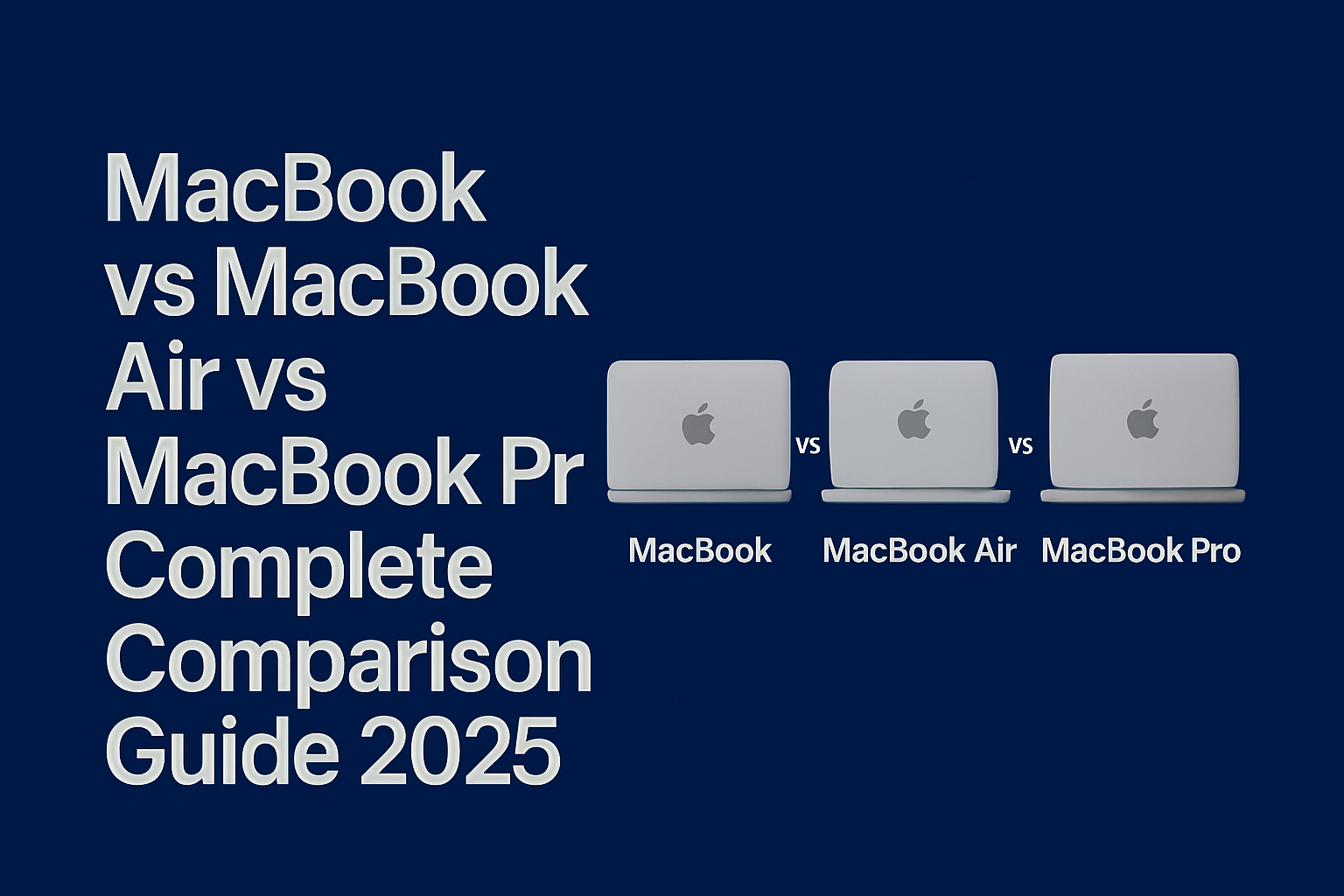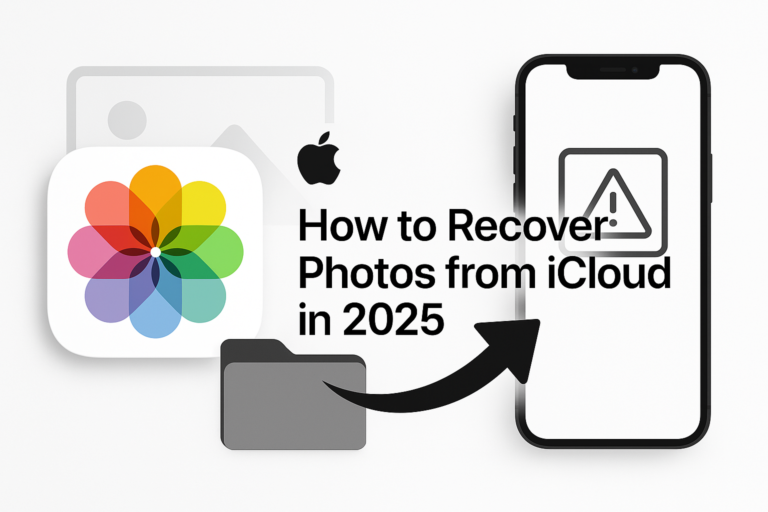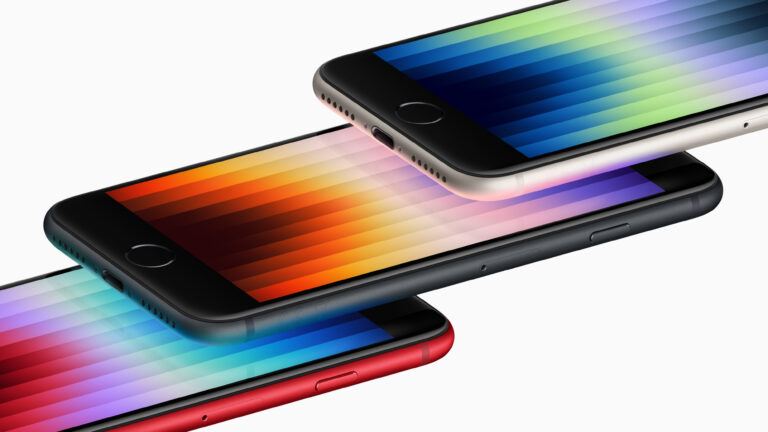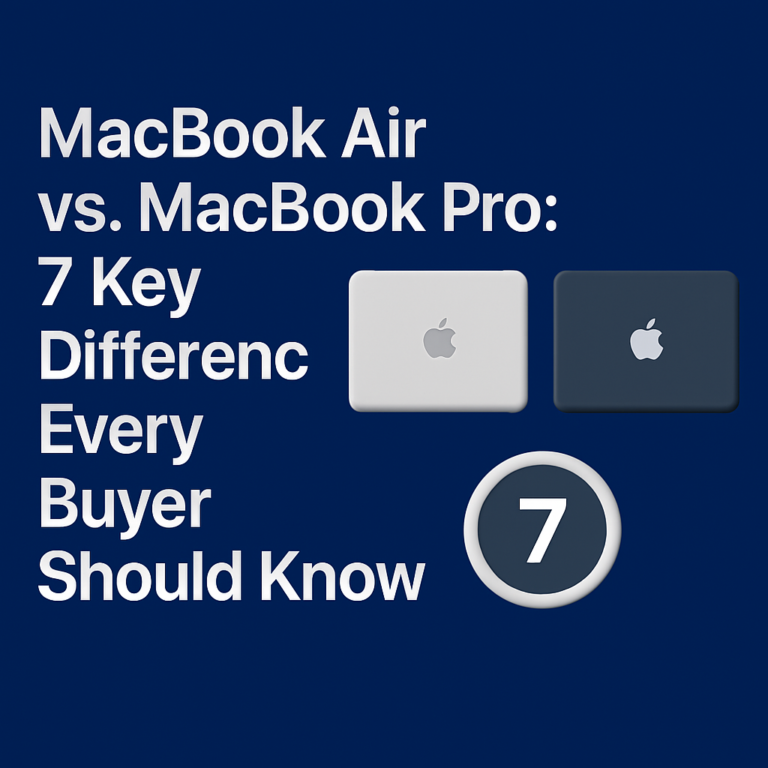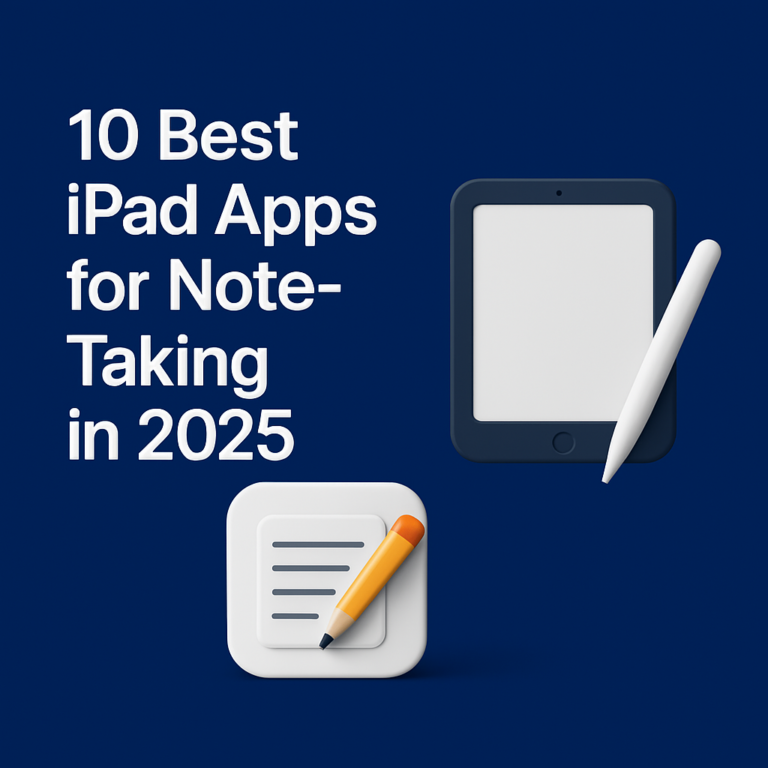MacBook vs MacBook Air vs MacBook Pro: Complete Comparison Guide 2025
Apple introduced the new M3 chip family, adjusted pricing across all tiers, and refined the lineup to fit a wide range of users, from students to software engineers to digital artists. With hybrid work now standard and more creators relying on portable performance, choosing the right MacBook is no longer about screen size. It’s about making a purchase that fits your future needs.
If you’re unsure which MacBook fits your needs, the wrong choice could mean wasted money or underwhelming performance. A student might not need Pro power. A designer might outgrow an Air too fast. This guide solves that.
It walks you through everything you need to know: from performance and battery to display quality, portability, and real-world use cases. Whether you edit videos, write papers, manage cloud servers, or just want the best value for casual use, we’ll help you match the right MacBook to your work and budget.
What Are the Differences Between MacBook Models? (And Why It Matters)
Let’s make this easy. Apple currently sells three core models:
- MacBook: Entry-level, budget-focused, best for everyday users
- MacBook Air: Lightweight, fast enough for most, ideal for students and mobile workers
- MacBook Pro: Powerhouse for creatives, coders, and professionals with demanding workflows
Each model targets a specific type of user, and Apple intentionally differentiates their performance, battery life, ports, and price. What you pick impacts not just how fast your machine runs today, but also how many years it stays useful.
Choosing the wrong one means either overpaying for unused power or underestimating what you need, risking early upgrade costs. There’s no one-size-fits-all here. This is about balancing value with function.
So if you’re a student, Air might serve you best. If you’re coding full-time, a base MacBook may feel sluggish. And if you’re editing 4K video or creating 3D models, a Pro will save you time (and frustration).
A Quick History of the MacBook Line
Apple doesn’t just launch products. It prunes, repositions, and reinvents. The 12-inch MacBook, once a fan-favorite for its ultra-thin build, was discontinued due to performance limitations. But in 2024, Apple reintroduced a simplified base MacBook, breathing new life into budget-focused Mac computing.
Meanwhile, Apple Silicon reshaped the Mac world. The timeline says it all:
Chip Timeline
- 2020: M1 changed the game by bringing blazing-fast speed and battery life to the Air and Pro
- 2022: M2 refined the formula, boosting performance and graphics
- 2023-24: M3 rolled out with new GPU cores, better AI processing, and improved thermal management
Today, all Macs ship with Apple Silicon. It’s the heart of what makes these devices so efficient.
Here’s a side-by-side look at the numbers:
| Feature | MacBook (Base) | MacBook Air (M3) | MacBook Pro (M3 Pro/Max) |
|---|---|---|---|
| Chip | M3 | M3 | M3 Pro / M3 Max |
| Screen Size | 13″ | 13″ / 15″ | 14″ / 16″ |
| Battery Life | Up to 15 hrs | Up to 18 hrs | Up to 22 hrs |
| Ports | 2x USB-C | 2x USB-C | 3x USB-C + HDMI + SD |
| Weight | ~2.7 lbs | ~2.8-3.3 lbs | ~3.5-4.7 lbs |
Benchmarks show the M3 Max nearly doubles the performance of the base M3. That means faster rendering, shorter compile times, and more fluid multitasking. It matters when time is money.
Design and Build Quality Comparison
Every MacBook feels premium, but the differences go deeper than materials. The base MacBook and Air feature a tapered, ultra-light chassis that prioritizes portability. These models also come in more colors—Midnight, Starlight, Silver, and Space Gray—giving users more personality in their gear.
The MacBook Pro is built for endurance. It uses a sturdier chassis, accommodates more ports, and includes an active cooling system. The extra weight comes with gains: better thermals, a larger trackpad, and a brighter display.
If you’re frequently on the move, the Air and MacBook shine. But for long editing sessions, coding marathons, or studio work, the Pro is engineered to handle it.
Performance: Which MacBook Is Fastest?
Short answer: the MacBook Pro. But let’s unpack why.
The M3 chip inside the base MacBook and Air is fast enough for everyday tasks: writing, browsing, Zoom calls, and even light media editing. You’ll feel no lag. But scale up to professional tasks, and things change fast.
The M3 Pro and M3 Max are engineered with more CPU and GPU cores. These chips handle logic-heavy workflows like 3D rendering, video encoding, and machine learning far more efficiently.
Real User Scenarios
- Writers/Students: MacBook or Air (even with multiple apps open)
- Developers: Air handles lightweight tasks, but Pro shines with larger codebases and containerized apps
- Filmmakers/3D Artists: Only Pro delivers real-time playback and quick exports
Battery Life: How Long Does Each MacBook Last?
MacBooks are known for long-lasting batteries, and 2025 models push that further.
The MacBook Air leads for casual users. Its fanless design and efficient chip stretch battery life to 18 hours on video playback and up to 15 for general use. The base MacBook is similar but slightly behind.
The Pro, with its larger chassis, houses a bigger battery. Despite higher power demands, it hits 20 to 22 hours of life under moderate use. Under heavy load, like editing or compiling, expect around 10-14 hours—still impressive.
If unplugged freedom matters, the Air is unbeatable. But the Pro offers stamina with strength.
Display and Graphics
All current MacBooks ship with sharp Retina displays, but not all screens are equal.
The MacBook and Air use standard Retina displays with P3 wide color and True Tone. They’re great for daily work, watching content, and even casual editing.
The Pro takes it further. Liquid Retina XDR technology supports HDR content, ultra-high brightness (up to 1600 nits peak), and smoother scrolling with 120Hz ProMotion refresh.
If you’re a designer, editor, or color-sensitive professional, this display is more than a luxury—it’s a necessity.
Price and Value for Money (2025 Pricing Breakdown)
Here’s a current breakdown of 2025 pricing:
- MacBook (Base): From $999
- MacBook Air: $1,099 (13″) to $1,499 (15″)
- MacBook Pro: Starts at $1,799 and stretches up to $3,999+ fully loaded
MacBooks are expensive, but they hold value. Their longevity, software updates, and resale prices often justify the upfront cost. Still, not everyone needs Pro-level speed.
Price Tiers
- Under $1,000: Entry-level tasks, best for students
- $1,100–$1,500: Balanced power and portability
- $1,800+: For serious creators and professionals
Pros and Cons of Each MacBook
MacBook (Base)
- 🟢 Affordable entry point
- 🟢 Enough for web, docs, and calls
- ⛔ Slower under load
- ⛔ Fewer ports
MacBook Air
- 🟢 Best battery and portability combo
- 🟢 Quiet, fanless performance
- ⛔ Limited for graphics-heavy tasks
- ⛔ No ProMotion or HDR
MacBook Pro
- 🟢 Unmatched performance
- 🟢 Best screen, best ports
- ⛔ Bulky for travel
- ⛔ Pricey for casual users
Tips for Choosing the Right MacBook
Still unsure? Use these quick prompts:
- Are you mostly in the browser or Office suite? → MacBook
- Need something light to carry all day on campus or remote gigs? → MacBook Air
- Editing YouTube videos or building apps? → MacBook Pro
- Want a machine that lasts 5+ years? → Lean toward Air or Pro
Always match your pick to your most demanding task, not your everyday minimum. That’s how you future-proof.
Recommended Resources
Want more? Dive deeper here:
- YouTube Reviews: Check real-world speed, thermals, and battery
- Apple’s Official Compare Tool: Specs side-by-side
- Top Reviewers: iMore, The Verge, MKBHD
- Tools & Add-ons: Consider hubs, stands, sleeves, and docks to upgrade your setup
Conclusion
Each MacBook model shines in its own zone. Students and light users can thrive on the MacBook or Air. Professionals pushing pixels or code should lean toward the Pro.
What matters most is matching the tool to the task. You don’t need the biggest Mac. You need the right one. A smart choice today saves you from regrets tomorrow.
For more personalized help, explore our buying guides or use the Mac Finder Tool.
P.S. Want more Apple gear breakdowns? Stick around.

